Photokina - Day 2
Fuji
First stop today was at Fuji, to see the S5 Pro. Meir, you asked, “Is it just a camera behind glass?” Umm, yeah. Pretty much. What I saw spinning in the glass case was a Nikon D200 with Fuji S5 Pro written on it. Ooohh, exciting. No S5s to handle and no one really talking about it at the booth.

Fuji S5 PRo looks like a Nikon D200
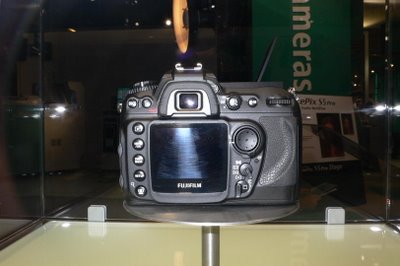
Still looks like a D200
So, I checked out the 20x30 prints that were hanging next to the camera. These are supposed to show you why you need one of these instead of a D200 or any other camera for that matter. I always say, “The proof is in the print.” Yeah, not so good. Soft pictures with nice, saturated Fuji colors. There appeared to be a lack of sharpness and artifacts around edges and the overall image was pixilated. What do I know, I only run a pro lab and see prints this size every day coming off our Durst Theta…
Apple
I was curious to see how Aperture 1.5 was shaping up and got a demo of it. The program appears to be quite nice and offers the convenience of great integration with Apple’s entire suite of iLife applications. For example, to publish pictures to a blog or online portfolio, you just drag images out of your collection in Aperture and into whatever application you wish to use them in, all without processing or exporting. That’s pretty sweet. I’m a PC/Capture One guy myself and I thought it was something I’d like to try. I still have issues with the whole single file library, so I won’t be running to my local Apple store just yet. Also new for 1.5 is that the program has been speeded up and should run on most any Mac, including the Mini. The machine I saw the demo on was a dual 3.0Ghz Mac Pro with 8GB RAM, and the Apple guy made a comment that his system had been dragging a bit all day. The comment came about 30 seconds before he went to “About This Mac” and saw he was running the fastest Mac Pro available. Good thing they got the speed thing worked out, huh.

Mac Pro running Aperture 1.5 on twin 30" Cinema Displays
Eizo
Just a step away, I stopped by Eizo to drool over the Color Edge CG221, one of the few monitors on the planet that can represent AdobeRGB color space. 22 inches of color-accurate love, right there. At over $6,000 each, I’ll have to make due with my 24” Dell Ultrasharp for a little while longer.

Uber-glorious Eizo CG221 LCD
Leaf
There’s been a bit of a buzz about Leaf’s new MF digital camera, the Leaf LFi. Yet another camera behind glass, except this was clearly a mock-up, not a working camera. I asked for product literature and they didn’t even have any yet. I was told to come back tomorrow for a booklet.

Leaf LFi - clearly the LCD has been mocked up here

Leaf CFi from the side
My time at Leaf wasn’t wasted though. I got some hands-on with the new v10 software. They had a bunch of Aptus 75 backs on various cameras surrounding a still life scene and tethered all the cameras to workstations flanking the studio setup. Detail, of course, was amazing, but the color response was improved from what I had seen previously. There were many color presets for different backs and scenes. We chose Still Life 5 and it was beautiful without any tweaking at all. Kudos to Leaf for improving their software, which now is available for both Mac (universal binary) and WinXP.

Leaf still life setup
Sinar
Trying to get to the bottom of what the Leica/Sinar deal really means, I headed over to Sinar’s booth. What did I find, but the exact same camera as the Leaf LFi, except this one was called the Sinar Hy6.
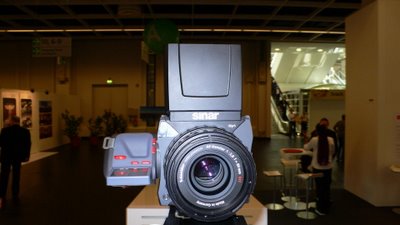
Sinar Hy6 from the front

Sinar Hy6 from side
Oh yeah, and I was able to take pictures with this one. The ergonomics were interesting, with a forward-slanted handgrip showing exposure info on a small LCD. The auto focus was a bit quirky, and I was able to manually focus using the waist-level finder a bit faster and more accurately. What I do find extremely interesting is the fact that it supposedly syncs at 1/1000th of a second. Perhaps engineering/technology partner Franke & Heidecke brings a little something to the table here. I’m curious how this all shakes out for Sinar and Leaf, but word is that you must use a Sinar back on the Sinar Hy6 and a Leaf back on the Leaf LFi.
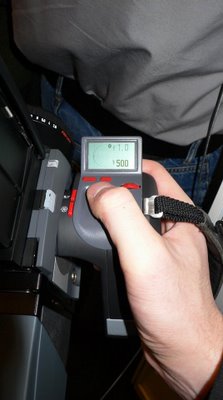
Status LCD displays exposure data (although it is incorrectly displaying f/1.0 for an f/2.8 lens
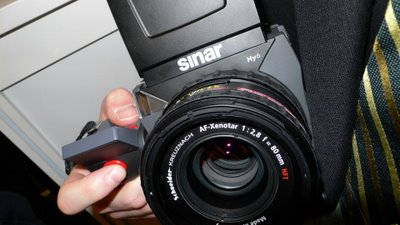
Shutter release is on underside of grip, trigger style

Sinar Hy6 with eMotion 75 back
After all this high-tech stuff, we took a break for the meat and potatoes photo gear at the huge Bogen area. All the Bogen brands had booths adjacent to one another. This made quick work for us.
Lastolite
First up, Lastolite. Almost all the product in the Lastolite booth was new. Most exciting products were the EzyBox Hotshoe, the white vinyl roll background, and the HiLite background. When giving my Nikon Wireless Flash System workshop, I really wanted to put an SB-800 in a softbox, but to no avail. Umbrellas are no problem using the Manfrotto 2905 Umbrella Swivel Adapter, but no matter how many Super Clamps and flex arms I used, I just couldn’t make it work for a shoot-through softbox. I suppose others have wanted to do this as well, because the EzyBox Hotshoe is a collapsible 2’ x 2’ softbox that holds a hotshoe-mounted flash unit.
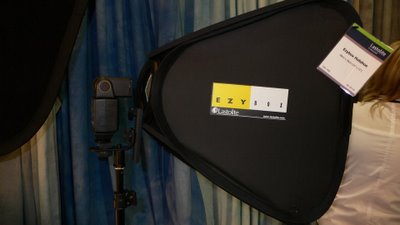
Lastolite EzyBox Hotshoe
Second on my list was a simple 10’ white roll background made of washable vinyl. Simple, elegant, very white, very durable and very reusable. Forger white paper rolls. Nuff said.
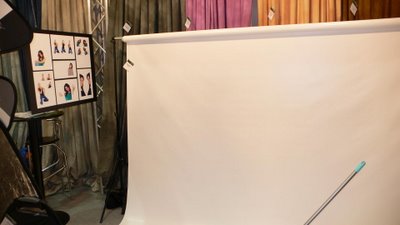
White vinyl background - sometimes simple is good
Lastly for Lastolie was an ingenious setup called the HiLite. The HiLite is a collapsible background that fits in what looks like a 4’ disc reflector bag. It measures 6’ by 7’ by about 8” when set-up and has a slit in the side for a strobe head. The idea is that when you fire a strobe inside this white box, you get a perfect white background with no shadow at all. This is similar to a trick in studio, where you take the biggest softbox you can find, put your model in front of it, and crank the power up. This one costs a lot less, folds up into a flat disc, and sets up on location in about 2 minutes flat. Availability for these products is probably by the end of the year.
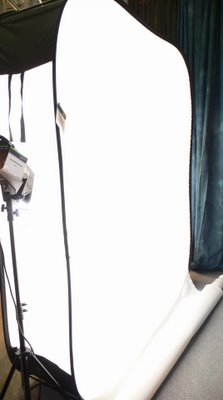 My flash triggered the slave on the strobe, illuminating the HiLite background
My flash triggered the slave on the strobe, illuminating the HiLite background
Whole HiLite background fits in that skinny blue bag
Manfrotto
Manfrotto had a few new products on display. At the forefront was the new 190XPro tripod. The special feature is a center column that can be set in the horizontal position from vertical in seconds. There were also a few new lightstands that looked promising. Many current stands are now being offered in black, with the addition of air cushioning and a new preset collar.

Manfrotto 190X
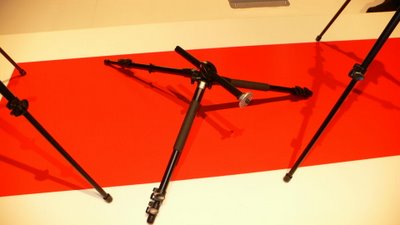
190XPro good for low-down macro work
Gitzo
Gitzo had a lot to show. The entire Mountaineer line is now 6x carbon fiber, including the 3 and 5-series systematics. There are two newly designed Aluminum tripods that utilize the tech-polymer Soulid 238 in place of aluminum for the collar section. This is the same material in the recently released G2180 fluid head with built-in counter balance. The G2180 will hold a 300mm f/2.8, yet only weighs in at 1.25lbs. Also, a Basalt explorer joins the lineup.
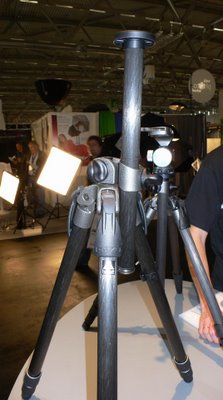
New Basalt Explorer
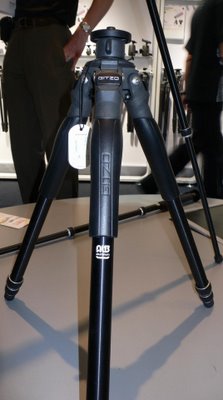
New Gitzo Aluminum tripod with Soulid 238
All the new tripods incorporate a redesigned leg-locking mechanism called a G-Lock. The more downward pressure applied, the greater the grip power. Compared to the first generation of the ALR (Anti-Leg-Rotation) locking system, the G-Lock has 20% less flex and more holding power. I put some serious rotating torque on the legs of a new 2-series and they felt rock-solid. For grins, I did the same with a 5-series Super Giant. I think I’d have more luck bending a steel crowbar than putting any amount of flex in those legs. Additionally, all tripods now feature the Ground Level Set, essentially a built-in short column. This weight-saving feature allows you to shoot almost flat to the ground.
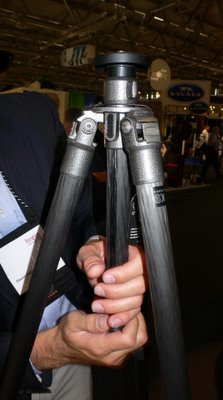
Removing the center column
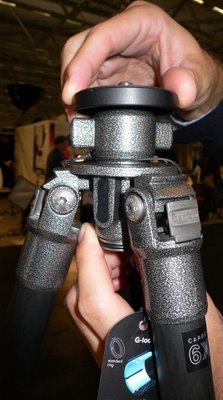
Securing the Ground Level Set
Profoto
Last stop on the tour today is Profoto. For those who may not know, we recently became Profoto dealers, both for Acute/Compact and for Pro-7/D4. The Swedish company was showcasing its new AcuteB 600 battery-operated power pack. It weighs in at 11lbs, compared to its cousin, the Pro-7b, at 26lbs. The pack offers 600Ws and is designed to drive only one Acute head. It recycles to full power in 2.8 seconds, roughly 2-3 times as long as the Pro-7b.
Honestly, for a retail of almost $3,000 I still think the Elinchrom Ranger RX or Speed RX is a better value. You get an 1100Ws pack that recycles faster, takes two heads, has shorter flash duration, shoots for over 1500 shots on a single charge, weighs half that of the 7b, and is completely weather sealed to boot. All for $2,500 in a complete kit with head and extra battery. I’ll be happy to try one out on a shoot, and I think Profoto makes great pack systems, but I believe they may have missed the mark a bit here. Undoubtedly, people will buy it. It’s new and it’s Profoto.

AcuteB 600 battery pack
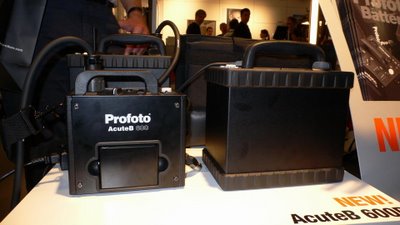
AcuteB 600 dwarfed by Pro-7b and B2

AcuteB 600 dwarfed by Pro-7b and B2
The Pro Ring 2 is the newest Pro head. In the ring is a 200W modeling light, which might prove extremely helpful in beauty and fashion. The really significant feature of the new ring is that it is now fan cooled, meaning you can shoot as fast as the Pro-7a will recycle (about three frames per second!). Currently, the Pro Ring, being convection cooled, can only handle 9600W per minute, which, if you’re using 2400W is only 4 shots per minute. You can shoot faster, but after chatting with the head of service, many people blow their $800 flash tubes this way all the time.

New Pro Ring 2 with modeling lighs on
Other Leica News
I did forget to mention something interesting yesterday. Leica is developing an adapter that will let you use R lenses on the Digilux 3. That one caught me by surprise. Also, after reading on dpreview.com that the 90mm f/4 collapsible wouldn’t work on the M8, I asked those in the know. This was a misunderstanding as the lens in question is not the 90 Macro, but rather the 90mm manufactured from 1954-1968. The macro lens can be used without any restriction whatsoever. Same with the 50mm collapsible-Elmar.
Day 2 is done (midnight here) and Day 3 beckons. Again, any requests, let me know. Stay tuned for updates.


1 Comments:
Any idea when Epson will show their new printer line? Will there be an update to the 3800?
Post a Comment
<< Home